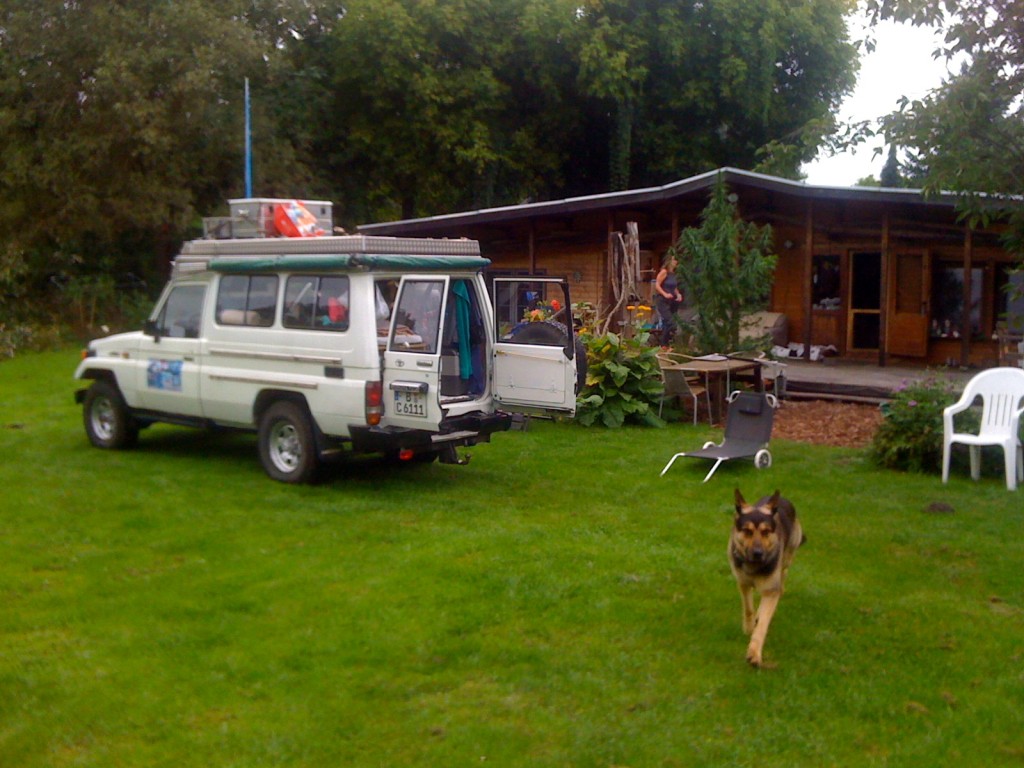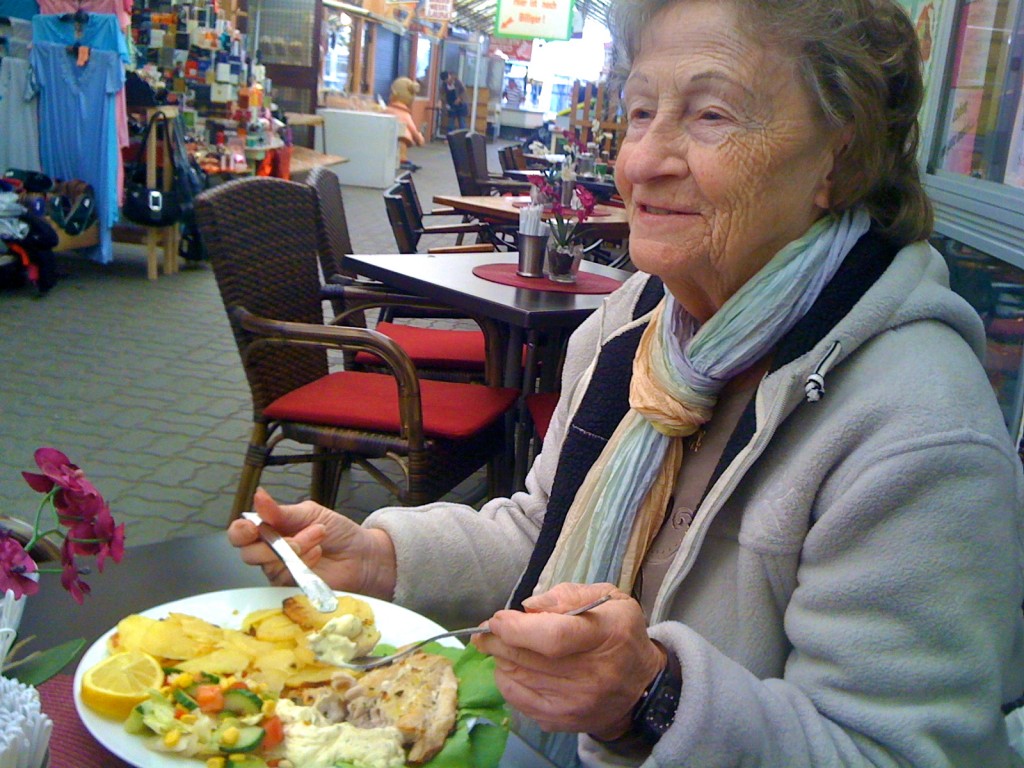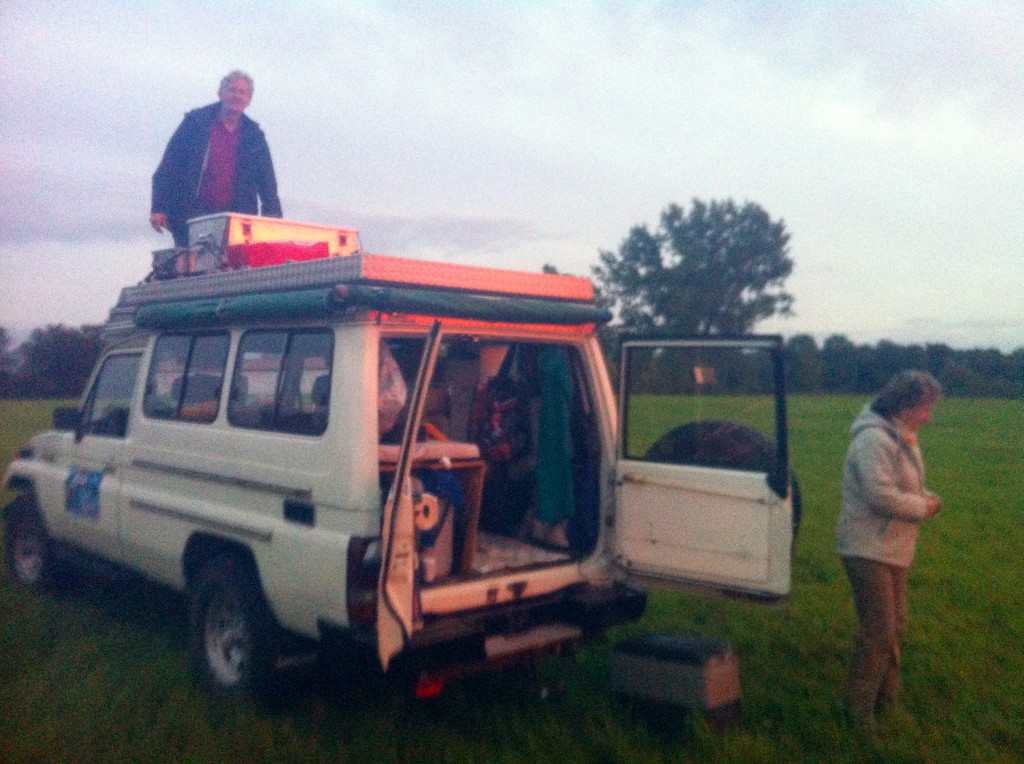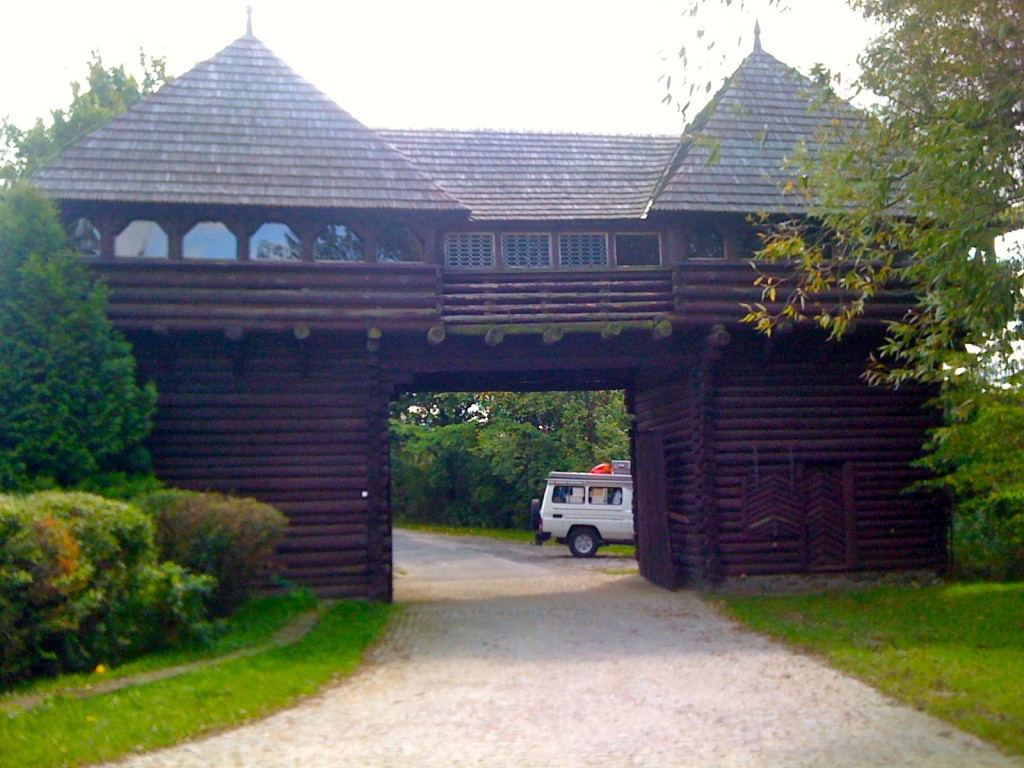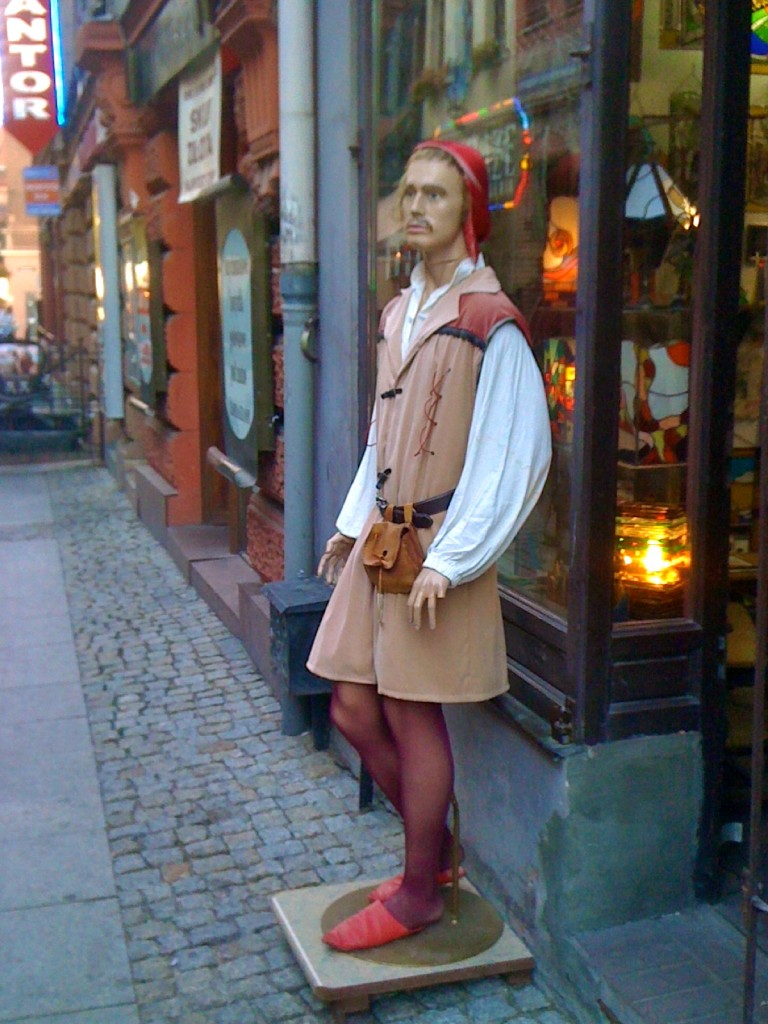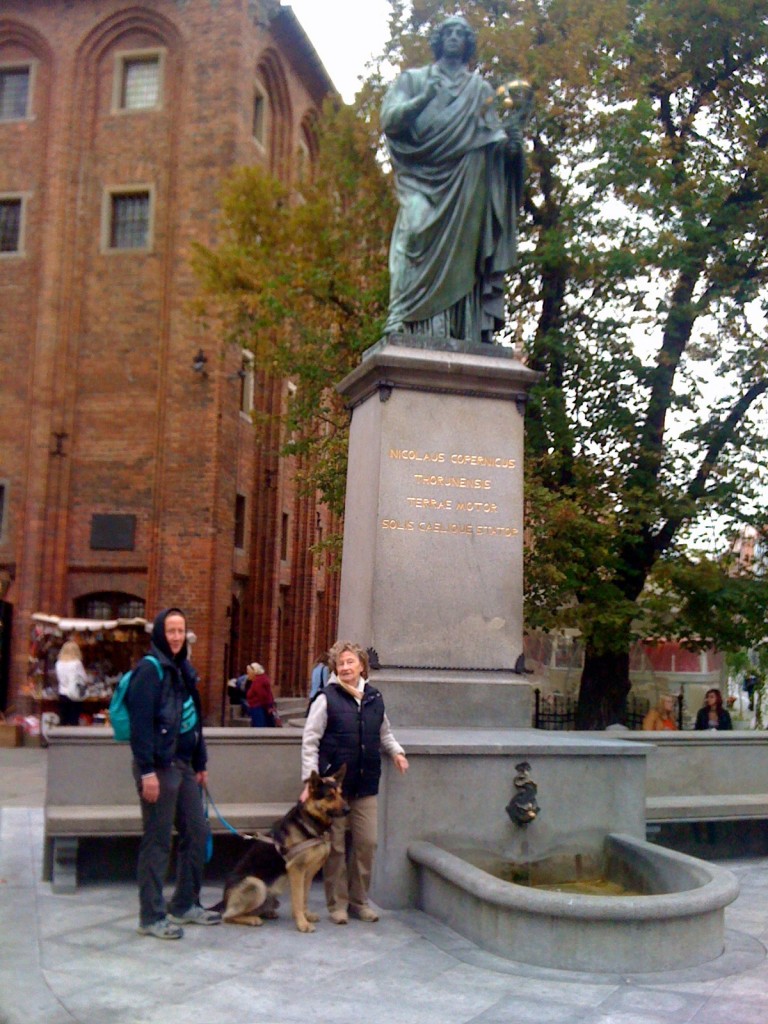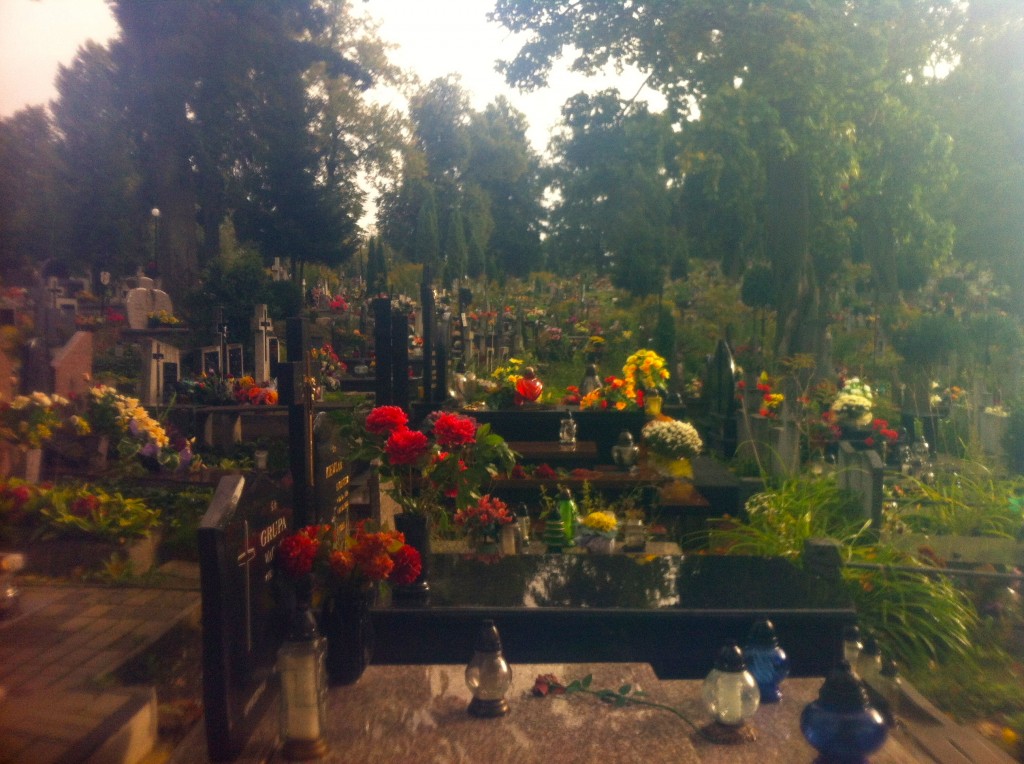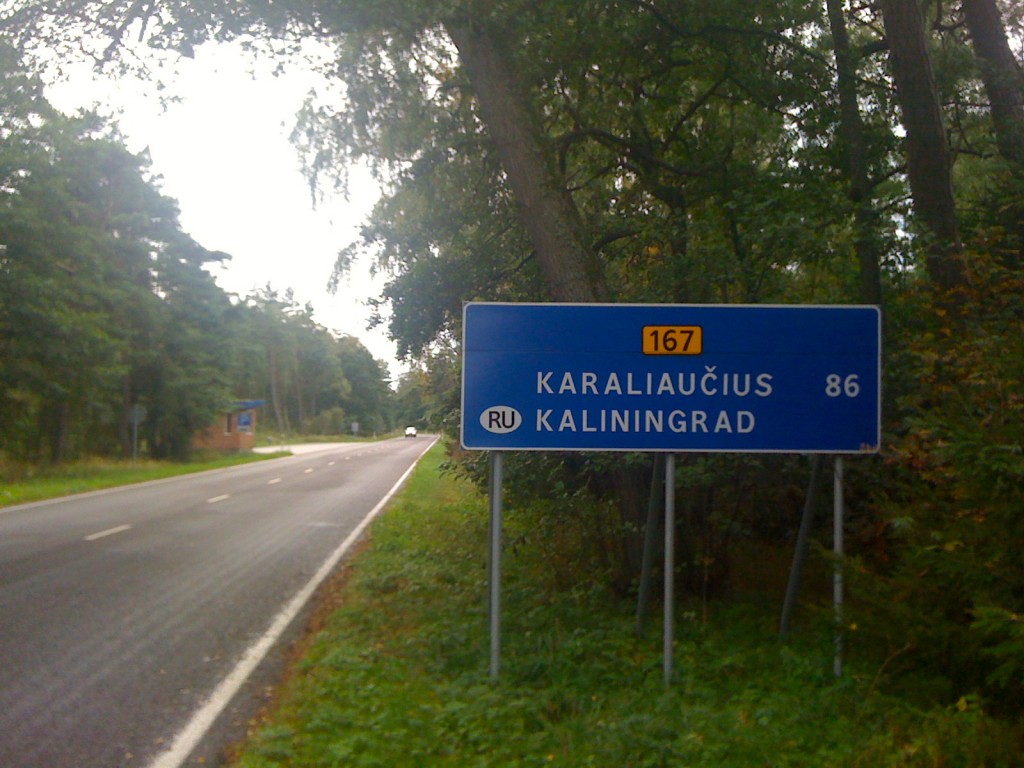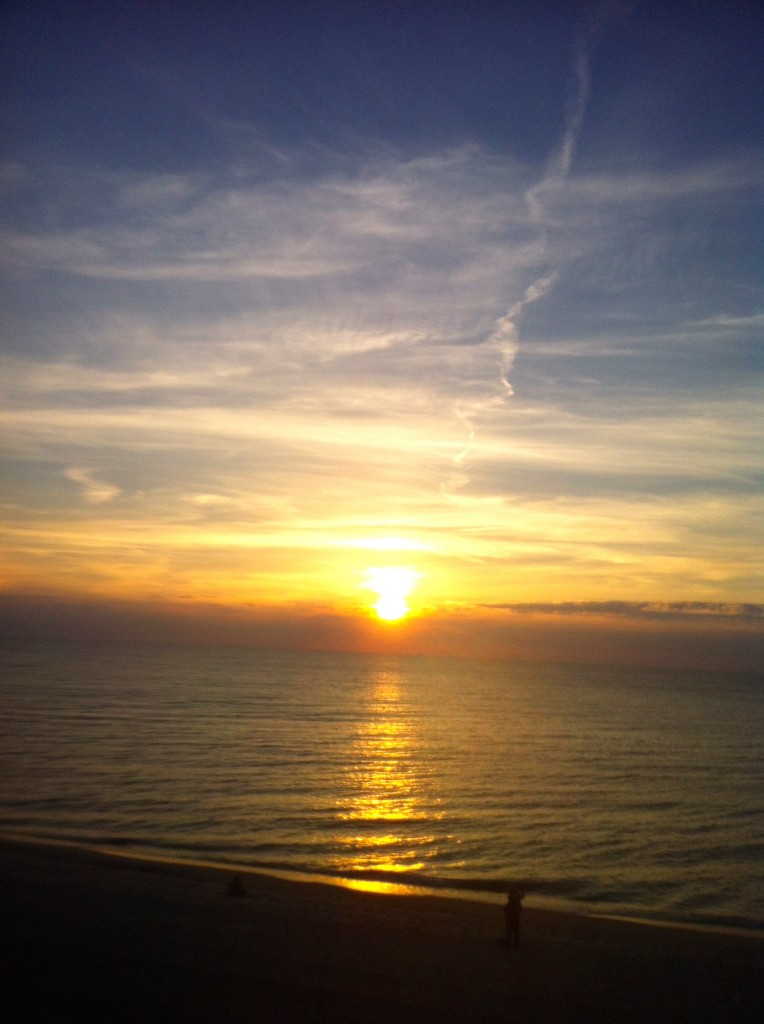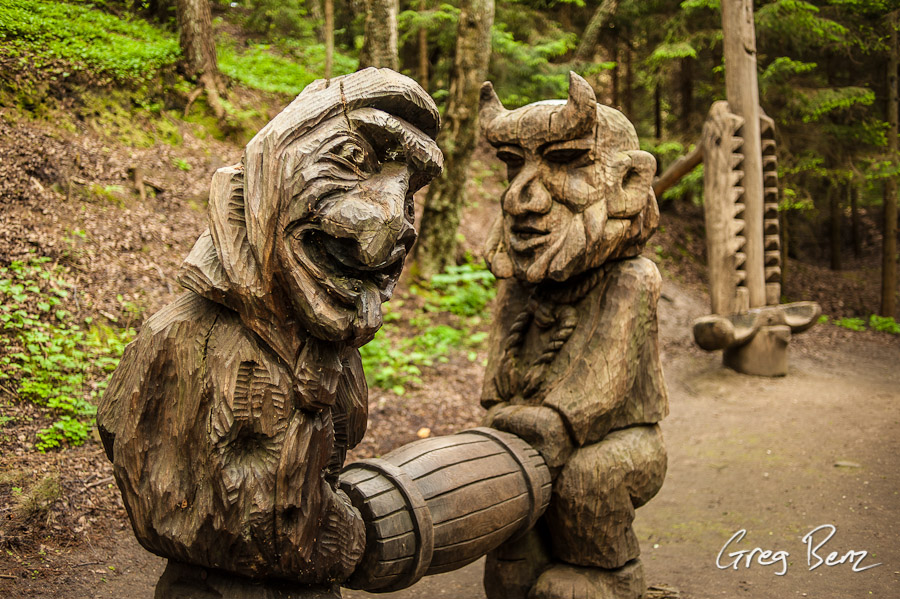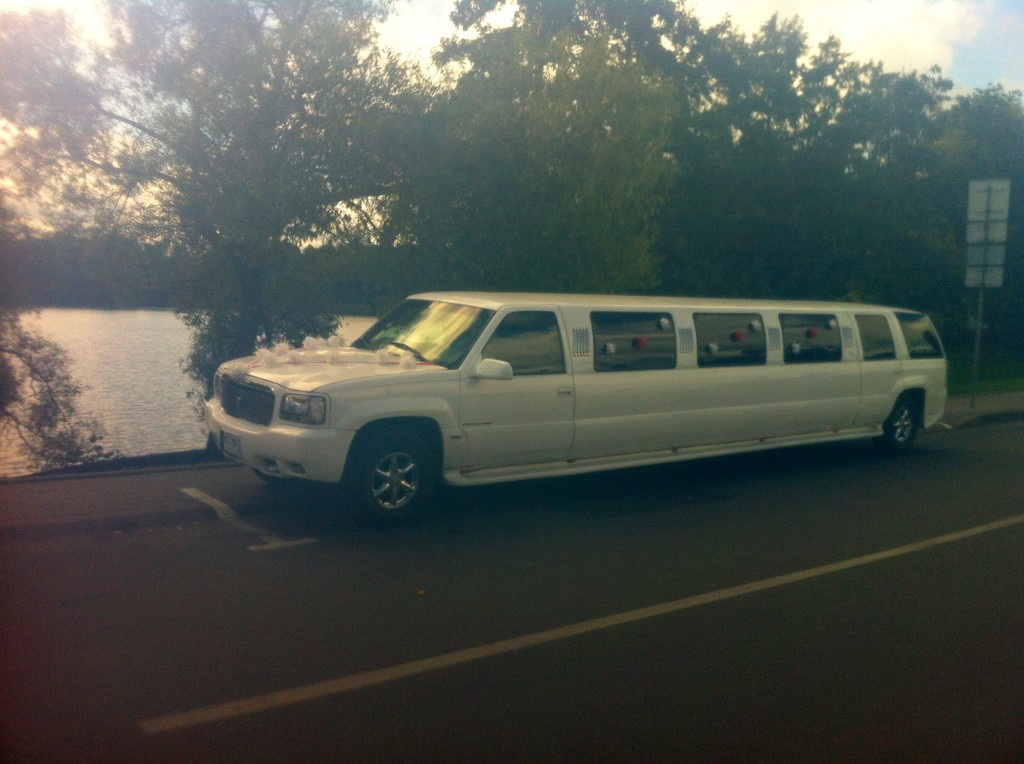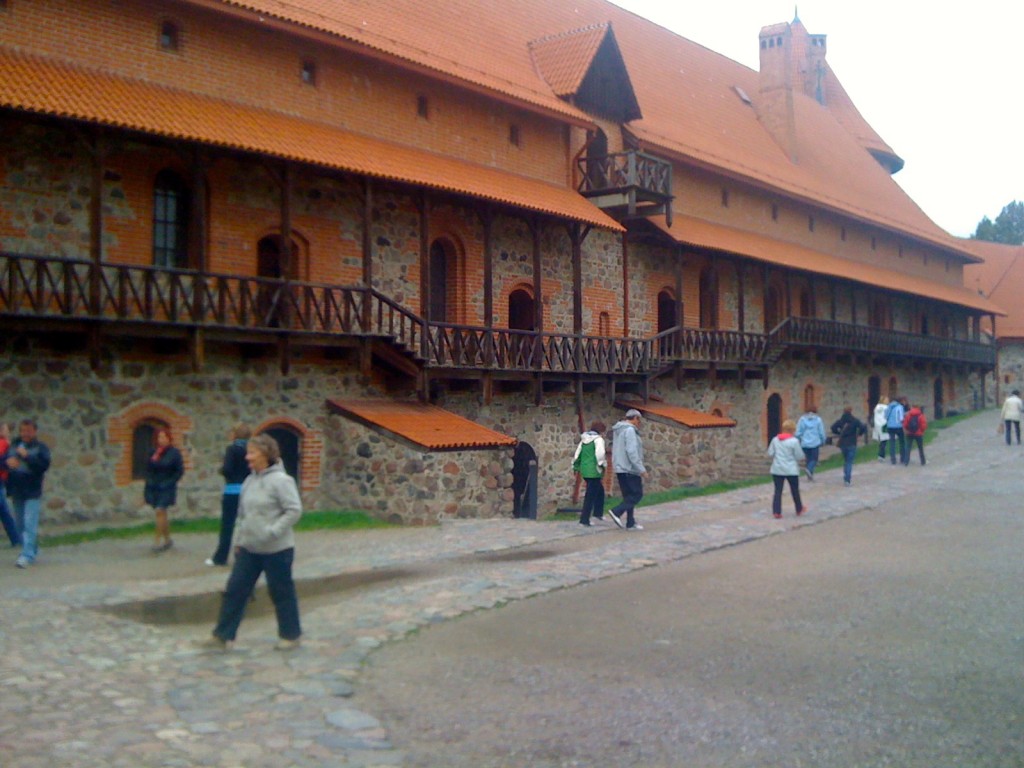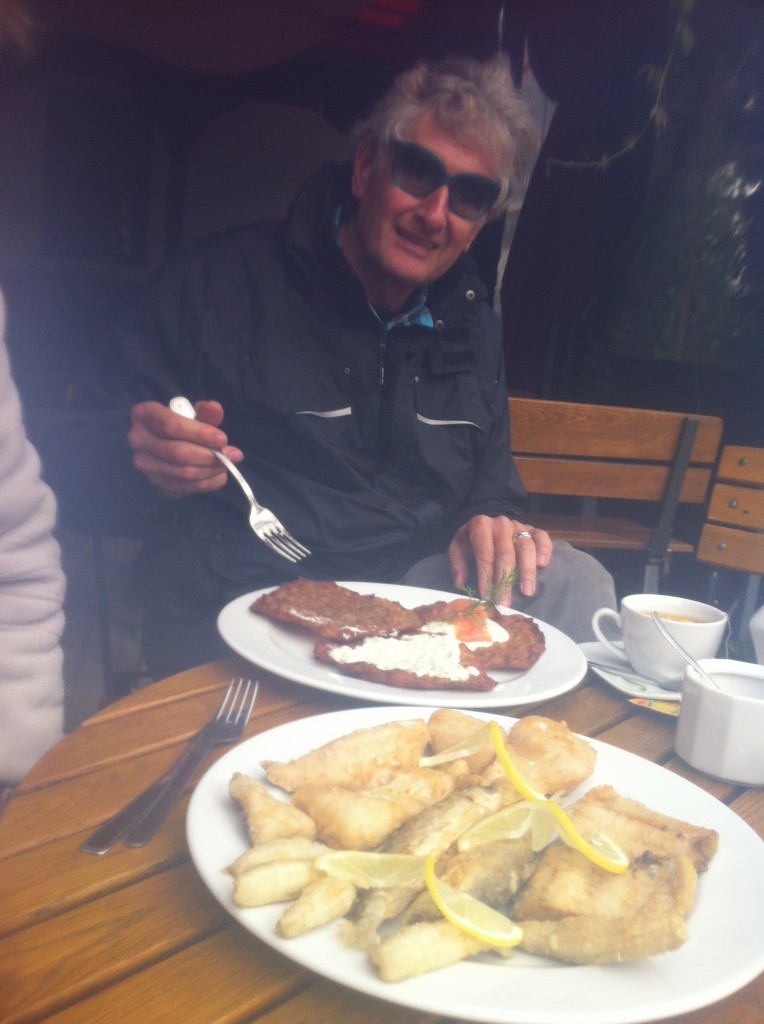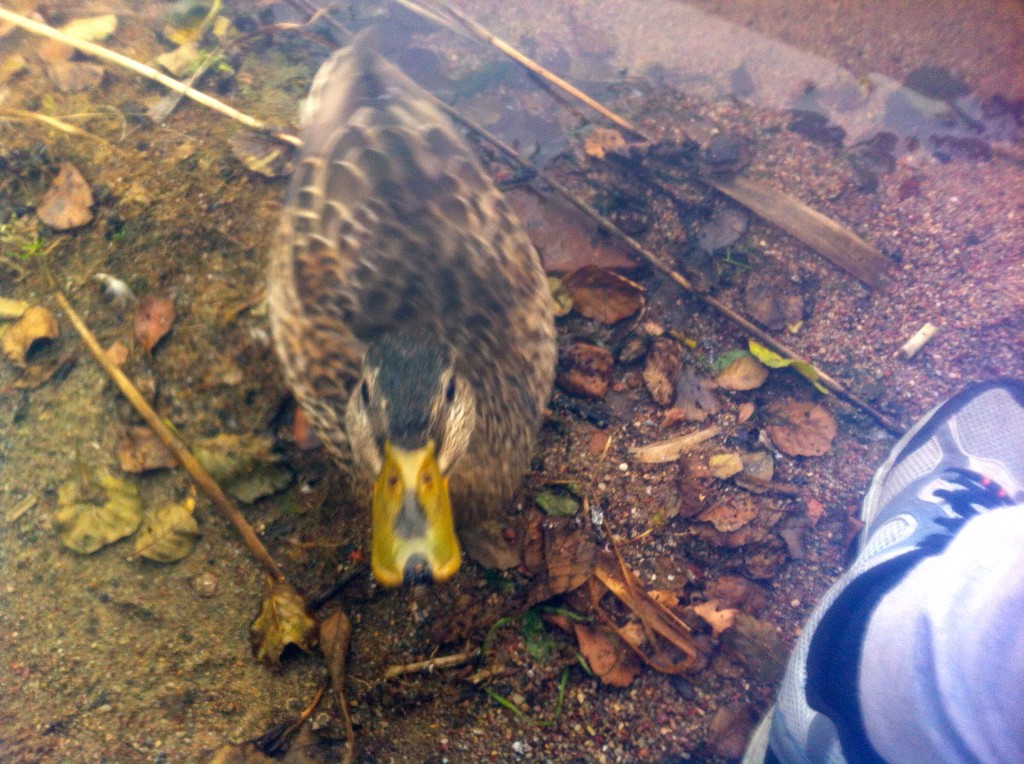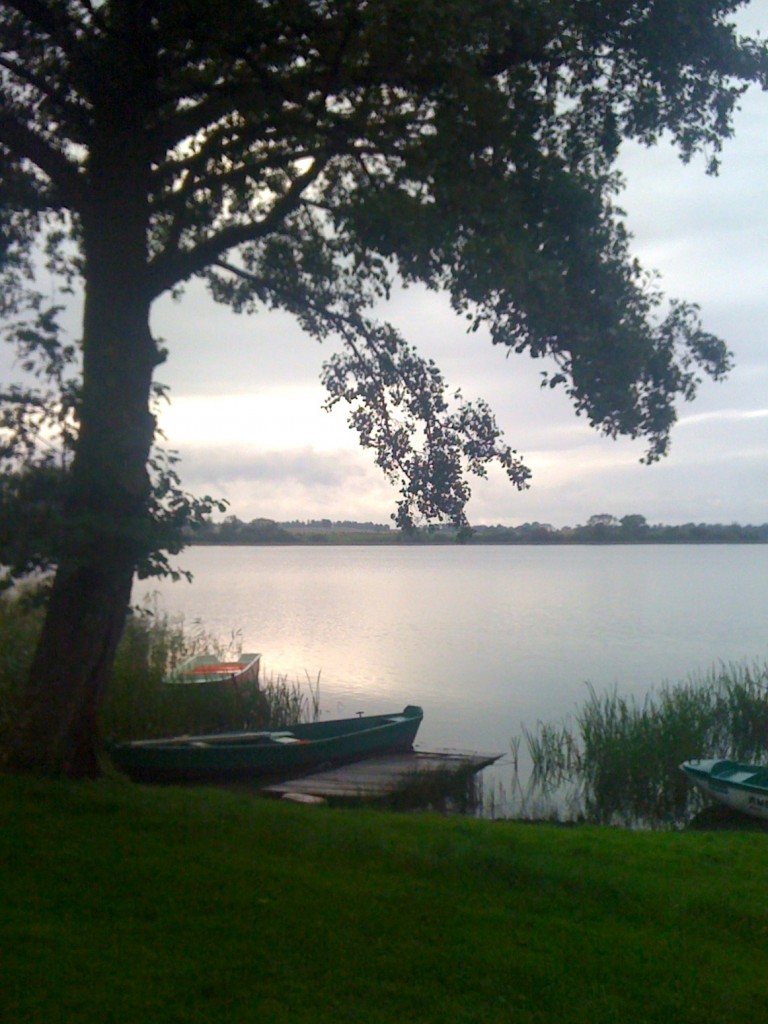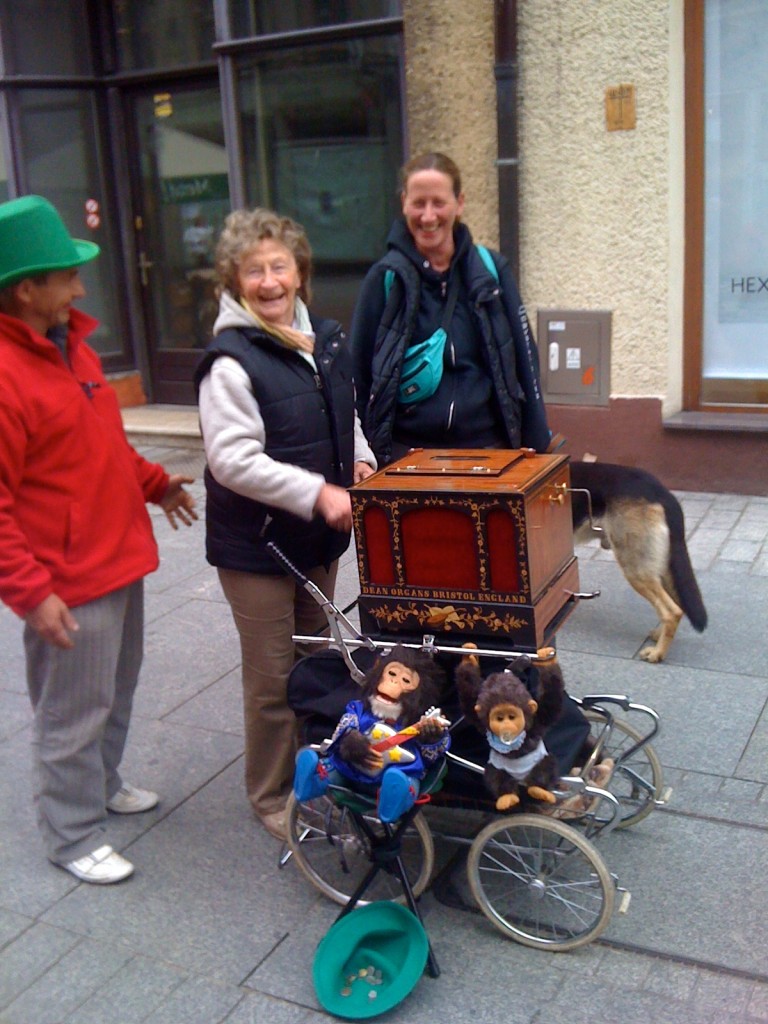Wednesday, Sept 5
This trip was a gift to Ingrid, my wife Claudia’s 79 year old mother. She wanted to go see Masuria, beautiful lake country in northeastern Poland where many Germans have roots, and which used to be part of Prussia-early greater Germany- for some four hundred years before the Second World War. She also wanted to see the bird sanctuary on the Curonian Spit, at the east end of the Baltic.
In preparation, we fixed up our Toyota Land Cruiser for the trip over several weeks, sanding down rust, repainting, rebuilding interior cabinets, creating a second outside awning, and getting repairs done to the drive chain and transmission.
We didn’t get away until after noon on a beautiful early September day, but who cares?
Getting to the interesting parts of Poland from Germany is a little like getting to the interesting parts of California from Phoenix. You gotta be willing to drive. Here’s where we went. It’s about 800 miles from Berlin to Nida on the Curonian Split, or about sixteen hours driving time, minimum. It’s about the same distance as driving between Albuquerque, New Mexico and San Francisco, California.
I had never been east of Berlin, so I was curious about the countryside and the towns. It took perhaps an hour and a half or two hours to get to the border town of Frankfurt (Oder) on the Elbe. at the border separating Germany and Poland. It is not the major financial city on the Mainz in western Germany, also named Frankfurt. Since Poland is an EU country (but on the Zloty, not the Euro), there was no customs at the border. It’s just a straight drive on, like passing from one state to the other in the US, but over the Elbe. Same with going from Poland into Lithuania. No customs, no stopping. Amazing. We stopped at a Polish market on the other side of the border where many Germans come to get cheap stuff. There were rows of covered stalls of clothes, farm produce, meats, and cheeses. People could get cheap haircuts and get their dogs groomed. Or get their dogs haircuts and get themselves groomed. Here’s Ingrid, inside the Polish market, enjoying her first of many seafood dinners.
The people there clearly eat too much wurst, like the Germans, and the middle aged women like to dye their hair platinum rainbow colors, like in eastern Germany. (Though I saw none of that during the remainder of the trip, either in the interior of Poland or in Lithuania.) We ate a late lunch at the market; I had half of a chicken, which seemed boiled and was small but tasty. Pickles are big side dishes in Poland and Lithuania. We then drove on past well-kept fields over excellent Autobahn to a campsite next to a museum by a lake – great ball throwing country for Dayo.
Thursday, Sept 6
In the morning we discovered that the island in the middle of the lake had been a citadel of 12th and 13th century Polish monarchs. There was a reconstruction of an early medieval fort, another museum, and a boat that took people over to the island.
In the afternoon we arrived in Torun, perhaps the largest and best preserved medieval old city in all of Europe. It is amazing for its size, the number of well-preserved, well-maintained ancient buildings, and the extraordinary variety of architectural styles. Torun sits on the north shore of a broad, beautiful river, the Vistula.
There is a hotel there that dates back to the 1200’s.
Parts of the old city walls and moats still exist.
 The streets are all cobblestone and have been turned into large pedestrian walking zones during the day and into the evening. This is a big area to close off, maybe a half a mile square.
The streets are all cobblestone and have been turned into large pedestrian walking zones during the day and into the evening. This is a big area to close off, maybe a half a mile square.
What you actually find as you walk around are buildings from every period from the 1200’s to the present, all refurbished to their original glory, and mixed together.
Here’s a spectacular one from maybe the 1500’s:
And something way different: A well-preserved neo-classical piece from the 1800’s:
As far as I could tell, the quality of life there is world class. You could get anything you want there, but cheaper, and without having to deal with the blatant commercialization. It’s like a cultural Disneyland, a real world Epcot center of one land but of many periods.
We had dinner at a pierogi restaurant – traditional Polish dough filled with anything you could find to eat. Scary. Mine had spinach and cheese. Not bad, but bland. Claudia’s had mushrooms and chicken, and was better. I am so far not impressed with Polish food any more than I am with German, both of which I put way up there with English food. (Consequently, these countries have a riot of imported foods. You see Turkish kebabs and even something also scary called a “tortilla,” of all things. It looks like stuff wrapped in a crepe.) The seafood in Poland is excellent though. So far I’ve only seen one Indian restaurant and NO Thai restaurants!
On the walk back to the campsite we stopped at a beautiful “dancing fountain” light show to music playing in front of the modern town hall. We stayed in a lovely campsite on the edge of the wooded floodplain of the river, across a long bridge from the old city. There was a very busy highway, the main one through the modern part of Torun, on the edge of the camp, but otherwise, it was nice. Ingrid stayed in a cabin and we parked Orange Crate (Claudia’s name for our Toyota Land Cruiser) next to it.
Friday, Sept 7
I got up and threw balls for Dayo in the big green spaces of the campground. The young son of the housekeeper of the camp came and I taught him to throw balls for Dayo.
Polish is a great language, particularly if you not only like consonants, but have a preference for Z’s, Y’s, and W’s, preferably in combination and with few vowels.
What is amazing is that there seem to be a lot of people who actually speak it. Not only that, but they have managed to build a well-functioning economy, as far as I can tell. The toilets flush. Hot water comes out of the faucets. The houses are remodelled or new; there are late-model cars. The Autobahn is as good as any you will find in the US or Germany, although it is a toll road and does not extend into too many areas of the country yet. However, they are building very good divided four lane highways throughout the country. I thought the farther we went east the poorer the roads would get. I was surprised to find the country lanes as well maintained as those in Germany.
Poland has been the beneficiary of tons of EU loans and grants for renewal projects, and they are building a first-class road system, much of it brand new. Of course the health and educational systems in Poland and Lithuania far surpass those in the US, because there is no obscene spending on military related boondoggles or narcissistic empire building projects. Also, they have parliamentary democracies that actually pass laws that are based on egalitarianism and pluralism rather than neo-liberal plutocracy.
We drove over to the old city and toured Copernicus’ large birth home there, dating from the 1400’s. Amazing. Before Columbus even.
Here’s another shot from in front of it, and no – that’s not Copernicus.
This isn’t Copernicus either.
I was interested in Copernicus because his heliocentrism turned over the world view in which man as the crowning glory of God’s creation was considered to be the center of reality. In Copernicus’ model, however, man is no longer the center of anything. Neither is Earth. And there s no God anywhere to be seen in his model. Copernicus was also a wise guy. He didn’t publish any of this until after his death, maybe because he didn’t want to get burned at the steak for heresy by loving Christians who only wanted to save his soul from eternal damnation. There was a copy of his seminal treatise on heliocentrism, written in Latin, of course, to gawk at:
and copies of the astronomical instruments he used to work out his computations.
In one of the city squares, in front of the town hall, stands a large bronze statue of Copernicus. Even the pigeons like him. It was fun to imagine Copernicus walking these streets as a boy. Here’s the statue of him in the town square:
In my work, Integral Deep Listening, a psychological autocentrism, or self-centered world view, is replaced by a multi-perspectival one which is the natural result of experiencing the perspectives of many different emerging potentials. So I have a soul brother kind of affinity for Copernicus.
In the afternoon we drove northeast, into the hilly, wooded, lake-filled countryside of Masuria.
Saturday, Sept 8
The country lanes in Poland are lined with beautiful old trees so that you drive through green tunnels for miles.
 We stopped at an Imbiss – a roadside snack stand – overlooking a lake and Ingrid and Claudia ordered fresh caught eel. It was fried, I think, and was very good, something that I wasn’t used to seeing on the menu in the US. We ate outside overlooking a beautiful lake where I threw balls for Dayo down the terrace to the water’s edge before driving on to Mikolajki. Mikolajki is a tourist haven on a huge lake in the hilly country of Masuria in NE Poland.
We stopped at an Imbiss – a roadside snack stand – overlooking a lake and Ingrid and Claudia ordered fresh caught eel. It was fried, I think, and was very good, something that I wasn’t used to seeing on the menu in the US. We ate outside overlooking a beautiful lake where I threw balls for Dayo down the terrace to the water’s edge before driving on to Mikolajki. Mikolajki is a tourist haven on a huge lake in the hilly country of Masuria in NE Poland.
It is a dock-side promanade full of sailboats, cafes, restaurants, sports rental stores, with all the amenities of any Western tourist trap.
However, the glories of Western consumer culture are yet to catch up to Poland and Lithuania. I have seen a few McDonald’s and one KFC, and there are plenty of advertisements for pizza, that international gourmet delicacy, but that is all. Few billboards. Hardly any graffiti. Few chain stores or franchises, praise be to Dog. There is very little litter in Poland or Lithuania. Fresh flowers fill graveyards in Poland
There were actual people coming out of real churches in Poland on Sunday morning. Can you believe it? In Poland Catholicism was part of the protest against communism. Therefore, there is a doubly strong cultural attraction to it: tradition and resistance. I suspect it will take another couple generations for it to die off in Poland like it is doing in Germany, England, Ireland, France, Austria, and Italy. My theory about all the fresh flowers in the huge and well-maintained cemetaries is that family is everything in agrarian cultures. Poland is still basically agrarian. The cemetaries are a testimony to the strength of family bonds, something that seems to die out in mobile, industrial societies. There is an innocence and naive sincerity about it all that is impressive, an anthropological time capsule like a lost Amazon tribe, a living relic of a bygone age that served to remind me how far and how fast we have forgotten our roots in the culture of secular humanism.
We stopped in a field by the large lake at Mikolajki so Claudia and Dayo could go swimming before heading to the campground. It was built in 1947 by the communist government and is in a beautiful location overlooking the harbor.
Claudia and Ingrid slept in one of the rustic cabins; I took one look at the sagging, narrow, short bunks and decided to sleep with Dayo in the land cruiser, even though it was sloping to the right, down the hill. Hey – once you’re asleep, who cares?
Sunday, Sept 9
We left our campsite overlooking the harbor at Mikolajki and traveled first through the hill country and then into Lithuania. It did not look as prosperous as Poland, although there are many late model cars of all kinds and people do not appear to be poor. Lithuania is also a member of the EU. I think it will take the economy another twenty-five years to recover from the Russians (who are widely still viewed as occupiers and exploiters) and the land at least fifty. But I could be wrong about that. Poland’s progress is amazing. When you have a dedicated, motivated, educated citizenry you can accomplish a great deal in a short time without a ton of resources. Most of the country we passed through in Lithuania was flat and agrarian, although in the south we went through some beautiful forest. We passed a lot of cows and a lady milking one in her field. The cows aren’t fenced in. Instead, they are tethered and farmers come out and move them to new patches of grass a couple times a day.
We had a long rest stop at a sunny peninsula on a lake in NE Poland. I threw balls for Dayo and took a nap. Ingrid sunned herself in a chair we brought onto an old wooden dock.
It was late when we left and we had to stay in a concrete slab campsite by the Autobahn in the city Kuanas, filled with ugly Plattenbau, gifts from the Communists. There is very little Russian language advertising to be seen in Poland and Lithuania. I wonder why. Ingrid seems to be doing OK now sleeping in Orange Crate. Here she is, reading her Kindle. The roof is raised and the sleeping platform pushed back and bedding rolled up to give her some room. So Ingrid slept downstairs with Dayo while Claudia and I stayed cozy in the master bedroom upstairs.
Monday Sept 10
Arrived in Klaipeda, a major port on the central coast of Lithuania, looking out on the Baltic to the west, and took the ferry
 across to the fifty or sixty mile long cresent of sand dunes called the Curonian Spit, covered with grasses and trees.
across to the fifty or sixty mile long cresent of sand dunes called the Curonian Spit, covered with grasses and trees.
It has broad beaches looking west out onto the broad expanse of the Baltic. Some of the dunes are over a hundred feet high. The southern 50 kilometers or so of the Spit is in the Russian exclave where Kaliningrad, formerly Königsberg, the capital of Prussia for four hundred years and where the great philosopher Immanuel Kant lived and worked, is located.
That exclave is still in a time warp. The roads are terrible and it is very expensive to enter (90 Euro per person!), if only to pass through from Poland to Lithuania. It mostly serves as a Russian military presence on the Baltic. The area was basically destroyed by the warring Germans and Russians in WWII and has been badly exploited by the Russians ever since. On the map above you can see that the bottom half of the Curonian Spit is yellow, meaning it is Russian. I took a picture of this sign just north of there, on the road that follows the Spit south to Kaliningrad:
Yes, that’s Lithuanian for “Kaliningrad!”
Nida is in the middle of the Curonian Spit, which is also a giant nature preserve for millions of migrating birds, both salt water and fresh water varieties. This Spit is maybe 100 miles long and between a half a mile and two miles wide, built up with sand deposited on top of moraines left from the last ice age. As the water level rose over the millenia, so did the sand deposits. On the left side is the Baltic, on the right is the gigantic fresh water lagoon, several times the size of San Diego or San Francisco Bays. There are high dunes on the sea side, then a lower area covered with trees, then still higher dunes with grasses and few trees on the fresh water side.
In the above picture, those are very wide, beautiful beaches on the Baltic. You can see some of the sand dunes on the fresh water lagoon side at the top of the picture. There’s a lot more of them than you can see in this portion of the Spit. The sands on the lagoon side shift so rapidly that entire fishing villages have been swallowed up by them. The area attracts both sea and fresh water birds. Huge colonies of Cormorants and Herons, for instance. Even under the Russians it was a nature preserve except for Nida, which was reserved for Soviet brass to come and recreate. They must have hated losing this very Tony water paradise.
Standing in Nida and looking south, you can see Russia, in the form of a high sand dune. The Spit continues on south for some fifty miles or so until one reaches the mainland of the Russian exclave.
Our apartment in Nida had two bedrooms, each with a double bed, and a separate kitchen. It is as nicely designed indoor and out as you would expect to find in a modern seaside accomodation in the US. This little town, Nida, is full of trees, flowers, and parks, with wonderful views of the huge lagoon or bay encompassed by the Curonian Spit.
Ingrid and Claudia spent some time on the beach in the afternoon while I watched from high up in the dunes. Later, after checking in to our very nice room, we watched the sunset over the Baltic sea from the top of the many steep steps leading down the dunes to the very broad, endless beach.
We had dinner in one of Nida’s excellent seafood restaurants, and I had the best seafood soup I think I’ve ever had. Also an excellent piece of fish covered with cheese. Dayo is allowed in restaurants there, as he is in Germany. He gets to pre-wash the plates.
Tuesday, Sept 11
While it was blustery and cool the first night camping, the weather had been mild and clear thereafter. But now it was raining; I stayed in and worked on my computer while Claudia and Ingrid went to the sand dunes.
 In the late afternoon we watched the sun set from the pier in the harbor.
In the late afternoon we watched the sun set from the pier in the harbor.
That wooden sailboat in the background is a lot bigger than it looks. It’s rigged like an old Lithuanian fishing vessel. You can see just how immense the fresh water bay or lagoon is there. Clauda and Ingrid like Nida and the Curonian Spit so much that they booked an extra night at our pension. Dayo got to meet a very lovely lady bulldog there.
We ate seafood at another excellent restaurant in Nida. In the evenings before bed I read Harry Potter auf Deutsch. I am on the second one and enjoying the stories at least as much, if not more, than the first reading years ago.
Out the window at night you see the flashes of white light as the beam of the lighthouse above Nida sweeps by.
Wednesday, Sept 12
Nida is filled with red, brown, or green fisherman houses with white trimmed windows and blue roof trim that is crowned with decorated cross beams at the apex at each end. Many of these are now vacation rentals.
The restaurants, stores, and yards are filled with tons of cultivated flowers;
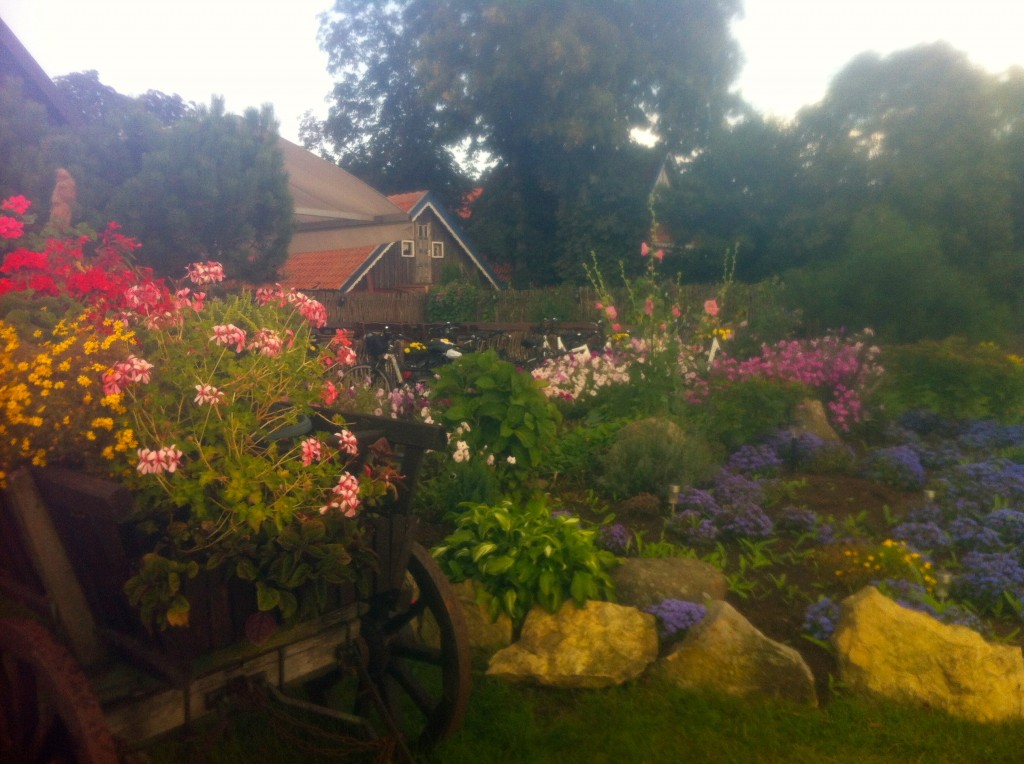 the public areas have sculptures, boardwalks, and the usual upscale amber jewelry souvineer stands. Ingrid bought a couple pieces, one for herself and another for her sister. Claudia and Ingrid went to the Thomas Mann house, the amber museum, and shopped. The amber museum includes, among other things, a fifty million year old lizard who is forever encased in amber. Sort of like the King Tut of lizards.
the public areas have sculptures, boardwalks, and the usual upscale amber jewelry souvineer stands. Ingrid bought a couple pieces, one for herself and another for her sister. Claudia and Ingrid went to the Thomas Mann house, the amber museum, and shopped. The amber museum includes, among other things, a fifty million year old lizard who is forever encased in amber. Sort of like the King Tut of lizards.
In the afternoon we went to the Lithuanian border with Russia to the south on the peninsula, because I was curious. While EU countries have nothing at the border, Lithuania and Russia are divided by a two and a half kilometer no-man’s land. The roads in the exclave are so bad that it takes you as long to traverse it as it does to go all the way around it via Lithuania, through Kaunas. This was disappointing, as I would have liked to have seen the place where Kant lived and worked,
Kaliningrad was a place of pivotal and dramatic fighting and ethnic cleansings. Here is Kalinigrad, 1945:
I also wanted to get a slice of contemporary Russian reality. History will tell that Europe and the US missed a major historic opportunity for statesmanship by not extending membership in the EU to Russia after its collapse in 1989. There was an absence of vision. The EU should not only have invited Russia into the EU; it should have offered it whatever incentives were necessary to make it happen. The status quo is a painful and unnecessary postponement of the inevitable-Russia’s eventual integration into western economies.
In the afternoon we traveled back toward the ferry and stopped at an amazing path up through the heavily wooded dunes at a narrow (maybe two or three kilometers wide) part of the spit. A very clever and talented local wood carver, beginning in the late 1970’s until the early 2000’s, placed wooden sculptures, themed on Lithuanian myths and most carved from tree trunks, along the path here and there. There are witches, goblins, devils, dragons, kings, princesses, fishermen, and thrones in all sorts of clever placements and depictions. Fascinating and quite impressive. One of my favorite parts of the entire trip! Here’s one of them:
We had seafood dinner at the same restaurant we ate at the first night in Nida. It was again excellent.
Thursday, Sept 13
We said goodby to Nida and stopped on the road back to the ferry to walk up to the top of the dunes overlooking the bay. You could look in the other direction and see the gorgeous Baltic sparkling in the sunlight.
It reminded me a bit of the ocean cliffs of southern California. Farther on we stopped and picked up a smoked eel and a mackeral for camp dinners.
We didn’t have to wait as long for the ferry going back; we drove through Klaipeda and then west past Kaunas to a campsite outside of Trakai, an ancient lakeside village near Vilnius, the capital of Lithuania.
Friday, Sept 14
In the morning light we could see the famous medieval castle at Trakai across the water sitting on its island. What a magnificent view!
This campground had a water slide and deck chairs on a beach in addition to all of the other usual amenities of EU campgrounds (hot showers, washer and dryer, electric hook ups, etc. etc.). We drove into town, parked and watched a couple of newlywed couples who I think had just gotten married in Vilnius, the capital (only 30 kilometers away) who drove in stretch limos with their entourage out for pictures by the shore in front of the castle. I saw a group of thirteen pile out of one flower-bedecked stretch limo.
Would this be part of your mental image of Lithuania? It wasn’t part of mine, either.
The castle is amazing. It is brick with tiled roof corner towers and looks like it dates from somewhere between the 12th and 15th centuries.
It has been completely restored to its medieval majesty.
Afterward we admired the swans and ducks while eating paninni and other totally non-Polish delicacies.
There were quite a few American tourists there, which amazed me – outside of Vilnius, Lithuania! Also a schoolbus full of French middle schoolers. When I hear someone speaking English I want to strike up a conversation, forgetting that the unusual familiarity is not indicative of much of anything worth cultvating. However, there were a couple of very interesting natives left over from medieval times:
The Lithuanians are quickly building a solid middle-class European society, like the Poles. Late model European, Japanese, and US cars are everywhere. The houses show pride of ownership, with most newly repainted. The young people look like typical Westerners. They could be transplanted to any US city and no one would tell the difference by appearances. No one looks poor, but they do well on a much lower standard of living than in the US, I think. They are so thankful to be out from under the Russians and to be members of the EU that they take little for granted. It’s only been some twenty years.
Claudia had set the Navi to get us to Augustow, Poland, by the quickest way possible, not realizing that meant going through Beylorussia. Of course you can’t do that without a visa that you must apply for in advance. So we stopped by a lake in a nature preserve close to the border and then cut west on country roads over to Sejni, Poland. The campsite was on the edge of a beautiful lake and opposite a church set on a high pedament overlooking a little village. It chimed the hour and half and hour and gave a recorded two-trumpet (or brass horn) melody at 10:00 PM and 7:00 AM.
Saturday, Sept 15
The campsite had an apple orchard; Ingrid and I enjoyed slicing and eating delicious fresh sweet green apples. We left our campsite north of Senji and south of Suwalki, in NE Poland, not far from the Lithuanian, Russian exclave (Kaliningrad) and Byleorussia borders. The trees were turning, with some bright yellow leaves and patches of red. I saw a lot of massive elms here, something I don’t see that much of in the US and Brandenburg, the area around Berlin. We had lunch beside the boat canal at Gizygko, between two large lakes in Masuria. A lot of thirty to forty foot long sailboats passed by with lowered masts, going under a train tressel from one lake to the other. They raise the highway bridge several times a day for the boats. Sitting there eating, watching the sailboats raising their masts again as they came out from under the train tressel,
and listening to Eric Clapton playing the blues and also some very good contemporary jazz made me feel like I was back in San Diego. Roller bladers glided along the boardwalk. Groups of older motorcyclers out on tour cruised by. It looked like upper middle class American culture to me. In north-eastern Poland. Dorothy, from the Wizard of Oz, would have turned to her little dog and exclaimed, “Toto, we’re not in Kansas any more!” I had Polish latkes – potato pancakes – in three varieties, with apple sauce and cinnamon, garlic cream, and lachs with sour cream. They were all amazing. Poles take their garlic very seriously. It is a gift that keeps on giving.
We drove to Swieta Lipka, a very bautiful baroque Catholic church which is one of two most beloved in Poland.
It was built in the late 1700’s and is surrounded by a very nice ambulatory. Also, instead of being full of crucifixes, it focused on Madonna themes and golden sun emblems of the Holy Spirit – much nicer. A lot of statues with a lot of gold. Silver too. A much better use of money than for education or health care, don’t you think? It also has an outrageous pipe organ with some 4000 pipes and little golden angels that blow trumpets and move, high above, among the pipes.
Very cheesy, but high art at the time. An impressive example of late seventeen hundred technology. We got to hear those pipes playing a number of classical selections, including Bach’s immortal Tocatta and Fugue. The bass pipes made the floor rumble. Wow. It was the most impressive organ I’ve ever seen or heard in my life. Because the church is not that huge, the organ almost overwhelms it. We also saw the beginning of a Polish church wedding in that church. It looked a lot like a US one, but this wedding had communion included. The organ music was fantastic, but it wasn’t good enough to keep me in a church during communion. That the proceedings were in Polish helped a great deal, but unfortunately I still knew what the priest was saying. And here’s the Polish answer to the threat of churches burning to the ground in celebration of Ash Wednesday: Electric offertory candles:
Very special, huh?
There is a beautiful big lake behind the church, so we threw balls for Dayo and Claudia got to experience her own mystic communion with one of the sweet duck natives, who waddled right up between her feet.
We drove on to Mragowo in search of our campsite for the night. Driving along the roads you occasionally pass roadside memorial crosses or obelisks or statues of Mary, all with flowers. At first I thought they were memorials for people who died in car crashes, like you sometimes see in the US. While some are, I am pretty sure a lot of them are simply signs of veneration put up by people on their property, along the street, maybe to keep vampires or the undead away. If so, they work; I haven’t seen either since I’ve been here.
Sunday Sept 16
We woke up in a beautiful campground above a lake south of Mragow, surrounded by some sixteen big travel trailers, most of them driven by older Germans. This place had massive sloping terraces down to the water’s edge, which was great for Dayo and ball throwing. Every night a different five-star resort view with our favorite cuisine by the lake.
I think Ingrid, who has never camped, has been having a great time roughing it. Our intention was to leave early for the long drive back to Berlin; that meant 10:00 instead of 11:00 AM departure. Amazing. Ingrid takes some time to get ready and Claudia was in no hurry to leave. I drove winding narrow country roads for four or five hours to Torun. If Ingrid ever needs a job, she can always get one there as an organ grinder in Torun:
It was a long drive back to Berlin; we didn’t arrive until some time after 10:00 Sunday night.
Wherever you go in the world you find that when people are left to themselves in their communities they will continuously improve the quality of their society, creating levels of culture and infrastructure that reflects lifetimes of care, concern, and commitment. We saw this all over Poland and Lithuania. This is the big story that doesn’t make the news. It is the way people are the same wherever you go, working toward the same ends, separated by governments and ideologies more than by language, and sharing with you a sense of what makes life worth living. I never would have gone to Poland or Lithuania if it hadn’t been for Ingrid wanting to go. I would have to say that I would be a smaller, more narrow person for not having been able to share, in some small way, in the amazing culture, history, natural beauty, and lives of good people about who I, a relatively worldly and well-educated westerner, knew next to nothing. If America has a financial meltdown and becomes a society more like Poland or Lithuania, I have a hard time seeing how that would be a bad thing. These countries are filled with good people, mostly living close to the land, who renew hope in the goodness of humanity.


